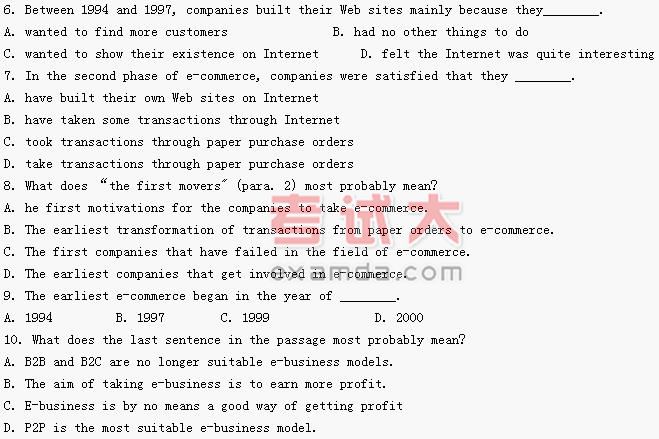The second part talks about how e-business applications are used for Internet, Internet or Extranet based applications. It looks at the questions from all perspectives, client software, middleware, and back-end systems. Using this information you are prepared to go online and discover other businesses, what they offer and how they did it.
The third part explains the technologies that are below your applications. This is done from a technical point of view as well as a business point of view, in order to show you the business cases that are viable right now. Each chapter contains a set of business cases that are evaluated and it is explained how Internet technologies help to resolve issues with the business cases or how to extend one's business through new technology.
The fourth part is an outlook into the future of electronic business and gets into more detail on how software and hardware will be developed in the future. The Open Source model is explained about how pervasive computing has been implemented.
Appendix A offers a glossary of e-business terms, which were used throughout the book. In case you do not understand a certain term, have a look here. Appendix B describes how a business can be moved to the Internet and what is required to do so. It does not only list the ideas, the required hardware and software, but goes also into detail regarding the costs and the benefits. Appendix C is a short list of my favorite web sites, ordered by subject areas.
1. The passage is most probably taken from ________.
A. an introduction to a book about e-business
B. one part of a chapter in book about e-business
C. an introduction to a book about computer software
D. one part of a chapter in a book about e-business
2. If one wants to get some information about ebusiness terms, he may best read ________.
A. Part One B. Appendix A
C. Appendix B D. Appendix C
3. If one wants to get some knowledge about how to communicate through Internet, he may best read ________.
A. Part One B. Part Two C. Part Three D. Part Four
4. If one wants to get some ebusiness cases, he may best read ________.
A. Part One B. Part Two C. Part Three D. Part Four
5. What is the best title for this passage?
A. Who should read the book?
B. Business on the net today.
C. How to do business through Internet.
D. The organization of the book.
(2)
The impact of e-commerce is happening in phases. In its first phase (1994—1997), e-commerce was about presence: making sure that everybody had a Web site, meeting the demand that every company, large or small, get out there and have at least something on the Internet. People weren't quite sure why they were doing it, but they knew that they had to have an online presence.
The second phase (1997—2000) of e-commerce was about transactionsbuying and selling over digital media. The focus in this phase was on order flow and gross revenue. Some of that was the matching of buyers and sellers who never would have found each other in the past. Some of it was simply taking transactions that would have been done through paper purchase orders and saying that this business was done on the Internet, although the meaning of that change was quite insignificant. But in this phase, the announcements were all about order flow at any cost: why-sell-it-when-you-can-give-it-away business models. As a result, many of the first movers in this phase such as Value America, are either gasping, have gasped their last breath, or are flailing about in a sea of red ink.
Today, e-commerce is entering the third phase (2000-?), with a focus on how the Internet can impact profitability. And profitability is not about increasing gross revenues but rather increasing gross margins. We call this phase e-business, and it includes all the applications and processes enabling a company to service a business transaction. Thus, e-business is not just about e-commerce transactions or about buying and selling over the Web: it's the overall strategy of redefining old business models, with the aid of technology, to maximize customer value and profits. To paraphrase Business Week: “Forget B2B and B2C, E-business is about P2P—path to profitability."

七、英译汉,阅读下面的短文,然后将划线的句子翻译成汉语(10%, 每题2分):
(请将译文写在答题纸上)
(1)
Communication can be the most critical aspect of whether a change strategy will succeed or fail. The degree to which information flows down through the organization can influence how well the change vision is understood and embraced. It can impact the values, behaviors and mindset of the workforce. It can either clarify or muddle a company's organizational structure and employee roles and it can enhance or detract from the culture the leadership is trying to maintain.
(2)
Executives who have successfully led change efforts advocate in-person discussions and meetings as the most effective communication vehicles.
(3) The degree to which information is shared across the organization can impact speed and flexibility tremendously. Lateral communication provides tools to take action. Continuous innovation, a critical element of e-business strategy, is at the mercy of an organization's communication structure.
(4)
In today's business environment, the challenge associated with communication is not simply one of volume. Instead, it is the need to reach the target audience (both internal and external ) with messages that include strategic, tactical and "WIIFM" elements. In the e-business environment, building a relationship with customers is critical, and this cannot be achieved without hearing their suggestions, needs and desires. To be effective for internal audiences, communication must share what is and what is not changing.
(5)
Communication builds commitment, and is the key to overcoming resistance to the change.
八、汉译英, 请把下列汉语句子翻译成英语 (10%, 每题2分)
(请将译文写在答题纸上)
1. 客户服务已经是并将继续是一个主要的竞争因素。(competitive factor)
2. 一开始,这个公司没有管理和业务计划,到现在为止一切进展顺利。(in place)
3. 我们在销售厂家的婴儿产品的同时也提供生活方式和健康方面的信息。(along with)
4. 现在,这家公司在刚刚建立自己的网站之后,正在寻求在其他玩具制造商曾经失败过的网上玩具商务中取得成功。(where)
5. 我们要在出发前把一切规划好。( plan out )